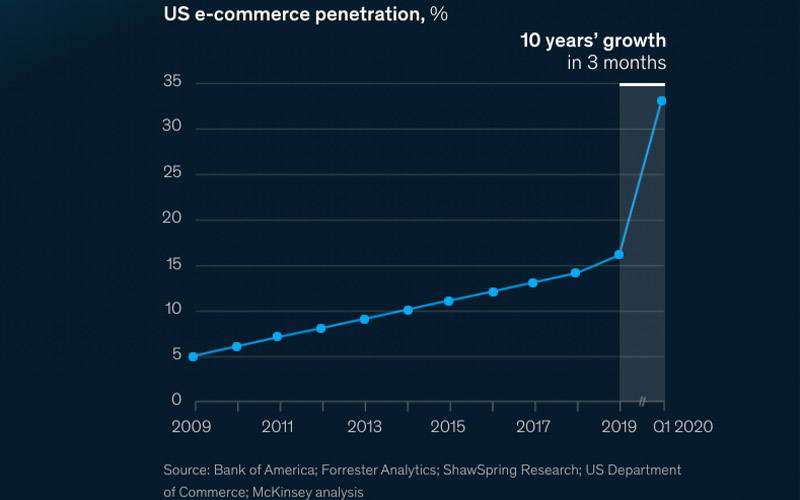Ecommerce in the age of COVID-19: 10 years’ growth ‘in 90 days’

McKinsey says ecommerce penetration in the US market has shot ahead over the last 3 months. (Pic: Getty)
In terms of investment narratives, ecommerce is shaping up as a sector that’s received one of the biggest tailwinds from COVID-19.
Domestically, that fact was borne out in a 2020 ecommerce report by Australia Post, which showed online sales rose by 80 per cent year-on-year in the eight weeks that followed the World Health Organisation’s declaration of a pandemic.
ASX-listed furniture retailers, such as omni-channel play Adairs (ASX:ADH) and online only platform Temple & Webster (ASX:TPW), reported half-year sales growth of more than 90 per cent in that time.
And new data from consulting firm McKinsey shows in the US market, the slice of the retail pie comprised of online sales has climbed from around 15 per cent to more than 30 per cent.
“If you’re feeling whiplash, it might be the 10 years forward we just jumped in 90 days’ time,” McKinsey said.

Online growth here to stay
While the early catalysts for the online shift were obvious, analysts expect the medium-term effect of the disruption will see broader online sales accelerate much faster than previously expected.
Australia Post general manager Ben Franzi said that instead of a 2025 timeline for online channels to take up 15 per cent of the domestic sales mix, he now expects that figure to be achieved by the end of this year.
Online growth rates have “normalised” slightly since the April surge but remain elevated, suggesting “this new normal may be here to stay”, Franzi said.
“As we progress through the rest of 2020, we’ll likely see the industry shift even further away from its previous state as retailers look to adopt a greater reliance on local manufacturing, re-imagine supply chains, and perhaps renew their focus on sustainability and social responsibility.”
However, it’s a rising tide that won’t necessarily lift all boats.
David Kirk, co-founder of investment firm Bailador, said investors still needed to look for companies that had strong straits on an individual level, such as a first-mover advantage and strong management teams.
“In that sense, online isn’t that different to offline,” he told Stockhead recently.
“You need to be able to drive customers to your website through different channels, then convert those customers. And that conversion is related to the quality of your product and its pricing.
“Then, particularly for online retailers, the offer around returns and delivery is important, along with a well-integrated supply chain to deliver products into Australia at the right cost. So we look for all of those metrics.”
Related Topics
UNLOCK INSIGHTS
Discover the untold stories of emerging ASX stocks.
Daily news and expert analysis, it's free to subscribe.
By proceeding, you confirm you understand that we handle personal information in accordance with our Privacy Policy.








